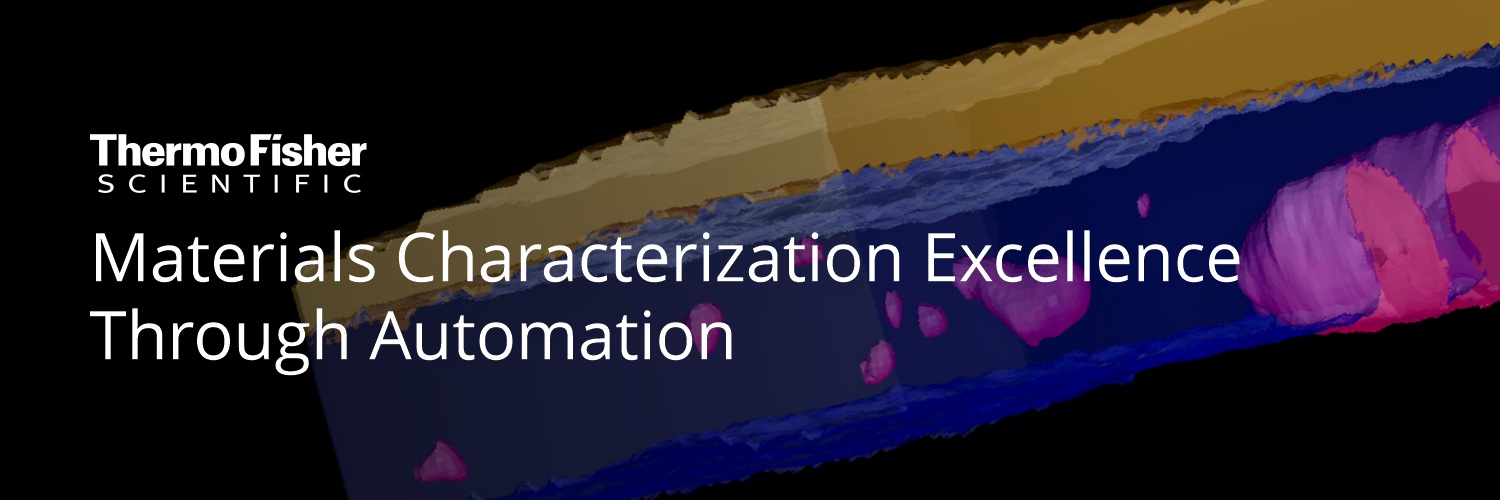Laboratory Automation Webinar Series:
Thermo Fisher Scientific is excited to present this 6-part webinar series focused on tools and methods to streamline research tasks through the use of automation.
Does automation feel like a black box to you? We will open it up for you in this series of webinars focused on demonstrating the power of automated analytical instruments to improve utilization, productivity, accessibility, and data reliability.
Thanks to automation, users in nearly every branch of science and technology can now spend less time on labor-intensive tasks like manual alignment and image tuning. In this 6-part webinar series, we will highlight applications in a wide range of analytical instruments from SEMs and TEMs, to FIBs, and more.
Achieve Higher Performance with your Microscope with Minimal Effort Using Automated Alignments
THU, SEP 2, 2021
Materials scientists and researchers have a wide range of needs regarding modern electron microscopes: high performance, versatility, and the ability to deliver the best results in a short time, all combined with a constant requirement of higher productivity.
To accommodate these needs, Thermo Fisher Scientific has developed a wide range of automated processes and alignments for SEMs, TEMs and DualBeams. Through these, users can spend less time on maintenance and image fine-tuning to boost their productivity and get better results.
Key learning objectives:
- Why automation is key in today’s remote work environment
- How optimized and aligned tools can improve accessibility and ease-of-use
- How microscopes can achieve consistent and reproducible results every time
- How automated alignments, diagnostics, and updates guarantee a superior level of robustness
Alice Scarpellini, MS
Applications Development Scientist,
Thermo Fisher Scientific
The Power of Scripting with a Desktop SEM
THU, SEP 16, 2021
Since 2005, the Thermo Fisher Scientific Phenom Desktop SEM product range has earned its place in the academic research and industrial quality analysis environment. Due to its speed and ease-of-use, this routine SEM imaging and analysis instrument provides analysts the capability to gather substantial amounts of data in a fairly short time.
The Application Programming Interface (API) enables the Phenom to interact with other software. Scripting enables operators to automate repetitive tasks, gather huge amounts of data automatically and save operator time.
Key learning objectives:
- How scripting works on a Thermo Fisher Scientific Phenom Desktop SEM
- How automation saves you valuable time
- How automation and scripting improve your results
Ruud Bernsen, BSc
Applications Specialist,
Thermo Fisher Scientific
Automated Particle Size Analysis for TEM
THU, SEP 30, 2021
Several analytical techniques focus on particle size analysis on the nm scale. Transmission Electron Microscopy (TEM) is ideal because it combines size and shape measurement accuracy with the ability to determine size distribution while dealing with aggregates of smaller particles.
A common drawback is that a TEM image typically contains dozens of particles which makes it difficult to acquire the >100 images needed to have a statistically relevant dataset. The automatic particle workflow (APW) from Thermo Fisher Scientific remedies that problem.
In this webinar, Thermo Fisher Scientific will discuss a strategy to employ APW on your TEM to perform element-specific particle size analysis in a more efficient and productive way.
Key learning objectives:
- How to run your TEM 24/7 – unattended
- How to significantly improve repeatability of your particle analysis on the nm scale
- How to remove repetitive manual analysis and operator bias
- How to quickly acquire statistics
Maarten Wirix, PhD
Technical Product Specialist,
Thermo Fisher Scientific
Unattended FIB Serial Sectioning Tomography for 3D Characterization Using Auto Slice and View 4
THU, OCT 7, 2021
Over the past 20 years, automated FIB-SST has become one of the dominant techniques for 3D characterization and analysis, allowing researchers to understand complex material microstructures or devices at the nanoscale in three dimensions.
Thermo Fisher Scientific was the first to develop and commercialize an automated FIB-SST application in 2000, then called “automated slice and view.”
This webinar discusses the current state of the art in FIB-SST and how materials scientists are using this application to develop new materials and answer complex questions.
Key learning objectives:
- How DualBeam FIB-SEM is used to automatically acquire serial sectioning data for 3D characterization
- Understand the most common sample preparation techniques for FIB-SST in a DualBeam
- How FIB-SST data is used to generate representative 3D reconstructions for real-world materials
Brandon Van Leer, MS
Sr. Manager,
Applications & Business Development,
Materials & Structural Analysis,
Thermo Fisher Scientific
Efficient Multi-Technique Surface Analysis Through Automation
THU, OCT 14, 2021
X-ray photoelectron spectroscopy (XPS) is one of the main analytical techniques for the chemical analysis of the surface of materials. Recent developments in instrument design have made it easier than ever to collect data.
Sometimes it’s necessary to add other surface analysis methods to the experiment to get a more complete understanding of the sample being investigated.
In this webinar, Thermo Fisher Scientific will present examples to illustrate how UPS, ISS, REELS and Raman spectroscopy can enrich XPS analysis, and explain how automation benefits this approach.
Key learning objectives:
- How developments in new instrument design make collecting data easier
- Why using more than one surface analysis technique increases your understanding of a sample
- How automation helps smoothen multi-technique surface analysis
Robin Simpson, EngD
Applications Scientist,
Thermo Fisher Scientific
Enabling Artificial Intelligence for Future (S)TEM Applications
THU, OCT 21, 2021
The applications of Artificial Intelligence and the use of neural networks are steadily increasing including (Scanning) Transmission Electron Microscopy. AI will increasingly reduce tedious tasks to single mouse-click operations and enable complex (S)TEM experiments we can only dream of today. AI will also become a critical component in the development of highly customized (S)TEM workflows to the extent that users will need the ability to script workflows themselves.
This webinar will provide an overview of the building blocks required for successful implementation of AI on Thermo Scientific (S)TEMs. It will also discuss proof-of-concept examples where AI makes a difference. We will also present the Thermo Scientific Metrios TEM, a dedicated tool for the semiconductor market, and the first (S)TEM running with minimal human interactions thanks to the assistance of “AI inside”.
Key learning objectives:
- Key features and benefits of using a Python based scripting interface product to access the microscope
- Examples of how AI can improve Materials Science applications in (S)TEM
- How the Thermo Fisher Scientific “AI inside” already makes a difference for semiconductor (S)TEM applications today
Eric Van Cappellen, PhD
TEM Business Development Manager,
Thermo Fisher Scientific






